A large chunk of the world has a problem that most westerners don’t consider when they turn on the tap: clean water (or rather, the absence thereof). Here’s a guide to getting clean water around the world, and how you can avoid problems when you’re traveling and living in places where clean drinking water isn’t a given.
I speak from experience, having dealt with parasites, bacterias, and even heavy metal poisoning.
Don’t be me. Read this post!
See also: Staying Healthy While Traveling: Natural Preventions and Cures
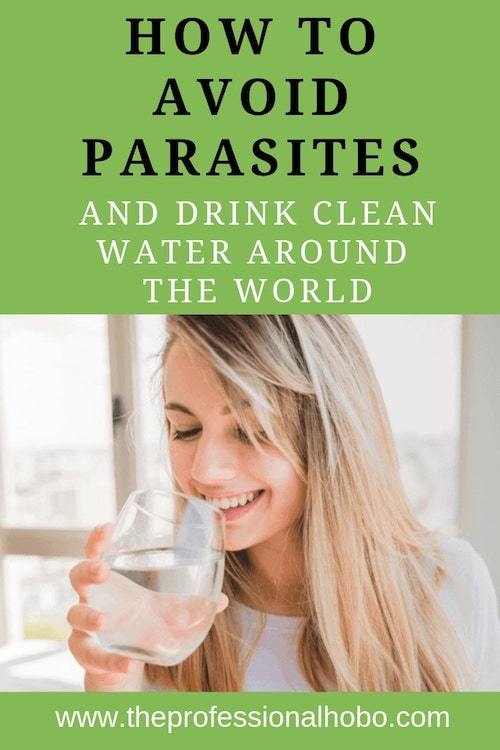
Note: This post was originally published in 2014. I have since completely re-written it to be a comprehensive guide that will keep you healthy when you travel. It’s about more than clean drinking water; brushing your teeth, cooking, and eating at restaurants are all hazardous if you don’t know what you need to know – which you’ll know by the end of this article.
Product recommendations in this article contain affiliate links, which earns me a (pitiful, but still important) commission on anything you buy. I appreciate your support in advance!
What is Contaminated Drinking Water?
According to the WHO, 1 in 3 people around the world do not have access to safe drinking water. At least 2 billion people use a drinking water source contaminated with faeces (ie: poop). Parasites in water can transmit diseases such as diarrhoea, cholera, dysentery, typhoid, and polio. All this is estimated to cause 485,000 diarrhoea-related deaths annually.
Death by pooping is no way to go. Not only that, but it’s entirely avoidable. (Read the rest of this article to learn how).
Countries With the Worst Drinking Water
While much of Central and South America, as well as most of Asia and Africa suffers from contaminated drinking water, here are the 10 worst offenders, in terms of the percentage of the population that has access to clean drinking water:
- Central African Republic
- Chad
- Tuvalu
- Sierra Leone
- Tanzania
- Democratic Republic of Congo
- Ethiopia
- Kiribati
- Malawi
- Laos
Parasites in Peru – My Experience with Clean Water (or Not)
I remember being in Nepal and telling somebody that I brushed my teeth with the tap water.
“It’s not a problem, is it?” I asked when I saw the look of horror cross their face. They told me about the numerous outbreaks of cholera in our neighbourhood that week. The cause of the cholera outbreak? The tap water. Parasites in tap water are nothing to mess around with.
Although you’d think I learned something there, I had to re-learn it – the hard way – in Peru…a few times over. What happens if you drink tap water in Peru? It ain’t pretty. The irony is I didn’t drink the water in Peru, but I still suffered.
I’m not sure how I contracted the first parasite (it could have been callously brushing my teeth with tap water, washing my vegetables in it and not drying them properly, or eating contaminated street food), but suffice it to say, it was a gastronomically unpleasant experience. (There are many types of parasites, but the parasites in Peru to beware of include giardia. Is giardia a parasite? Yep, it is; one that’s caused by water with traces of poop in it. Yummy).
After a week of being violently ill (diarrhoea, debilitating stomach cramps, and gas/burps producing rotten egg smells that I refused to own) and realizing it wasn’t going to go away on its own, I staggered into the local pharmacy and with my limited Spanish said “parasito”. Within seconds, I had a three-day course of medication (for $10) that cleaned everything up lickedy-split.
But I still hadn’t learned my lesson. During the two years I lived in Peru, I suffered many water-borne illnesses, before I finally figured out how to live in a country with contaminated water and not get sick.
Let’s look at some of these strategies.
How to Avoid Contaminated Water When Traveling
Contaminated water precautions go well beyond making sure your drinking water is filtered and/or sterilized. Here’s what you need to know:
WAYS TO GET CLEAN DRINKING WATER
This is the most important way of avoiding water related diseases, since the sheer volume of water we consume daily is in the form of drinking. Here’s how to get clean drinking water:
Fill Up Your Reusable Bottle
Most travelers carry reusable water bottles with them; and many hotels/hostels in countries with dodgy water have water coolers in the lobby or restaurant area. There’s a pretty cool app called Find Tap that will direct you to a nearby fill station, be it a restaurant or hotel or dispenser.
(See also: Best Travel Apps)
Filter or Sterilize Water
Using a variety of tools that I’ll delve into in the next section, you can filter or sterilize water from a variety of sources to produce clean drinking water without having to buy bottled water. This is what I have been doing for the last 10+ years, and as you’ll see, I’ve tried out quite a selection of water filters and purifiers.
Boil Water
Most of the locals in countries where you can’t drink tap water just boil it. How long does water need to boil to be clean? According to the US Centre for Disease Control, boiling your water for one minute will kill anything in it. At higher altitudes (above 2,000 metres), you need to increase the boiling time to three minutes.
Boiling water won’t deal with particulates, nor will it deal with any icky taste in the water. But it is certainly an easy way to get clean drinking water in large quantities.
Water Purification Tablets (Clean Water Tablets)
Admittedly, I don’t know any travelers who use clean water tablets. They’re known to leave behind an unpleasant taste, although these ones are the most popular so presumable they’re relatively palatable. The purification process isn’t instant, but with a bit of planning, these tablets can give you clean drinking water.
Top Water Filters for Travel
SteriPEN Water Purifier
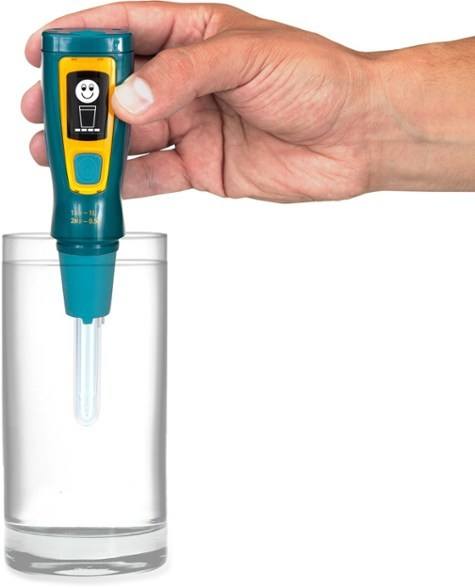
The SteriPEN Ultra is an ultraviolet water purifier that fits in your pocket and kills the bacteria and viruses that can live in water. I got one in 2008, and used it throughout a few months in Asia, saving the waste of 360 bottles of water, and saving money too.
It takes a bit of a leap of faith to shine this light in your tap water and to trust that it’s really clean water, but it worked a charm.
I like the Ultra SteriPEN water filter in particular of all the models they have, because it’s USB rechargeable, and made in such a way that when you use it with a bottle that has a standard water bottle opening, you can create a seal so that you can turn the bottle upside down to agitate the water to sterilize it properly.
SteriPEN problems include a lack of filtration. While it kills all parasites and bacteria, it doesn’t take care of heavy metals or plastic contaminates, both of which are increasing problems in many countries. One of the many ailments that took me down in 2017/2018 in Asia was a light case of heavy metal poisoning, after (I believe) drinking too much tap water that was sterilized but not filtered. Much as I love my SteriPEN, In the SteriPEN vs. filter battle, filters win.
GRAYL GEOPRESS
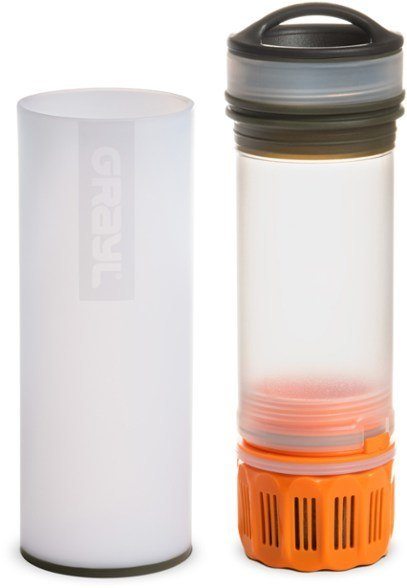
After my challenges with the SteriPEN, I got the Grayl Ultralight Water Purifier. I liked it because I could filter water and then drink it on the spot or decant it into water bottles so I had lots of clean water for a day out. Or I could drink directly from the Geopress and the water flow was fast because the water is already filtered.
While it’s known for producing great-tasting water and can be used anywhere (as long as the water is clear to begin with), it’s kind of a pain to use – literally; pushing the filter down is very difficult; filtering a lot of water at a time is no fun. Also, the filter replacements are quite expensive, and without the bottle system, the filter is useless.
LIFESTRAW
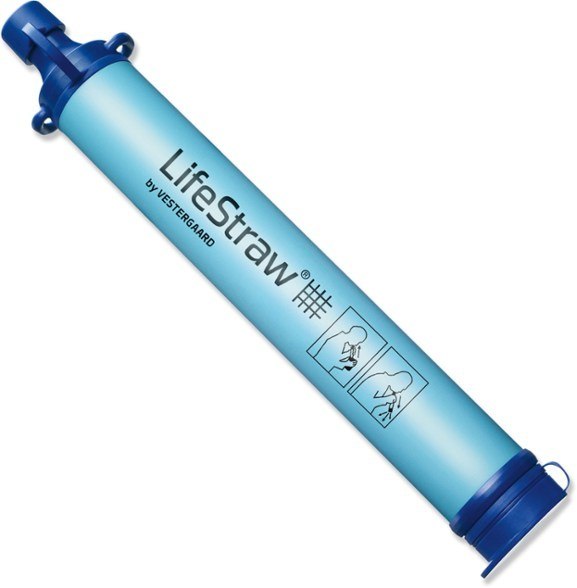
More popular than the Grayl is the Lifestraw Personal Water Filter. It’s basically a large straw-shaped filter that you can stick into any water source (their ads tend to show hikers using it to drink water directly from a river) and suck up totally filtered clean water. Because of its versatility and relatively compact size, Lifestraw tends to be a hit with not only travelers, but also backcountry hikers and people putting together “preparedness” kits (for storms, earthquakes, and zombie apocalypses).
Grayl vs Lifestraw: I have a few problems with the Lifestraw. First of all, when I’m really thirsty, I don’t want to suck my water through a filter/straw; it’s not a satisfying way for me to drink water. Secondly, there’s no way to use the Lifestraw to filter a lot of water at once, which is often necessary when preparing for a hike (and water sources like rivers aren’t always available). Third, with no way to decant water, I can’t use it to brush my teeth and rinse my toothbrush.
That said, travelers tend to go gaga for the Lifestraw GO Series Water Filter Bottle. Ultralight travelers will revel in the Life Straw Peak Series Collapsible squeeze bottle version (which can help with squeezing out water to brush teeth), though I don’t much like that it can’t stand up on its own.
SAWYER MINI
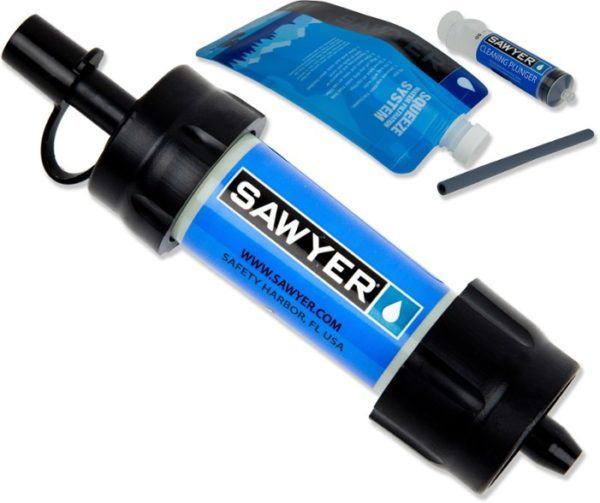
In an attempt to solve the shortcomings of the Grayl and Lifestraw, I came across the Sawyer line of filters, including the Sawyer Mini Water Filtration System (pictured above) and other models that seem to be perfect for travel.
I own the Mini system, but haven’t yet had a chance to put it through its paces. You can filter water much easier and faster than the Grayl. The filter can be screwed on to any water bottle with a standard-opening, so you can either screw the filter on to each of your water bottles as you need them, or you can use the straw feature to drink anything you want out of any vessel wide enough, or you can use the squeeze pouch to filter water into bottles in advance so you don’t need to carry the filter (though it’s very small). It’s lighter, more compact, and appears easier to use than its counterparts above.
However, I don’t believe this model filters heavy metals.
WATER-TO-GO (My Fav Water Filter Bottle)
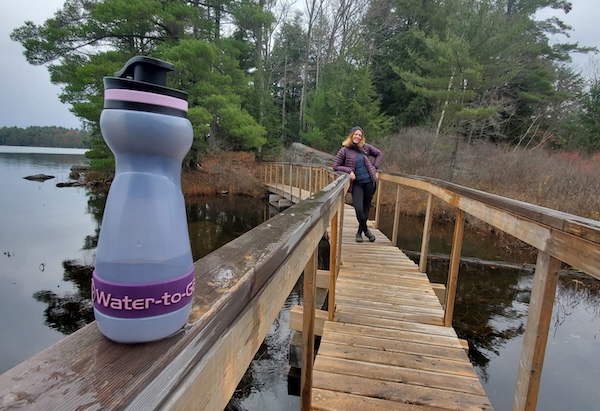
All these years of toiling and trying different water filters brought me to Water-to-Go. Using a bottle is as simple as filling it up, replacing the lid, and drinking. The filter works as you sip, removing contaminants including viruses, bacteria, parasites, chemicals, heavy metals, and microplastics. Note that I said heavy metals; I’m not sure any of the other filters in this article can make the same claim.
This impressive filtration is possible due to a unique combination of physical, chemical, and electropositive nano-filtration techniques.
These bottles allow you to drink from any freshwater source. I filled my bottle with the water from the lake pictured above (which was a bit yellow and not considered potable), and it came out squeaky clean. This level of protection has been validated by independent laboratories across four continents and by over half a million users globally. Each filter in these bottles can replace up to 400 single-use plastic bottles, contributing significantly to reducing plastic waste. Over the last decade, Water-to-Go filters have already replaced an estimated 180 million single-use plastic bottles.
While you can squeeze the bottle to get small amounts out (such as to decant into a glass to brush your teeth), Water-to-Go bottles are designed to purify water as you drink it. They are not designed to fill another vessel. So I have the same challenge with these bottles as with the Lifestraw Go, in that I’m beholden to having access to a water source (or bringing along additional bottles of unfiltered water) to refill the bottle, and I’m also beholden to sucking my water through a filter (which is a flow rate slower than I prefer to drink).
However, with such comprehensive filtration and also with what you’re about to read, these are small compromises.
One of the more notable developments in Water-to-Go’s range is the introduction of bottles made from sugarcane, a bioplastic that’s both sustainable and ethically produced. Sugarcane, being a carbon-sequestering plant, regrows quickly after harvest, making it a truly sustainable material. The harvested sugarcane is processed to produce sugar and ethanol, and the waste material is then used to create the plant-based plastic for these bottles.
Water-to-Go takes their commitment to the planet further with carbon-neutral packaging made from recycled cardboard and printed using vegetable inks. These bioplastic bottles are as durable and long-lasting as their traditional counterparts, designed for repeated use over the years.
Water-to-Go’s commitment to sustainability is also evident in their approach to product life cycles. The bottles are designed to be reusable, recyclable, and even the filter medium is compostable.
At the moment, Water-to-Go is my preference for water filter bottles. They provide safe drinking water from various sources while contributing positively to environmental conservation. With the company moving all their bottles to this bioplastic, they are setting a new standard in sustainable travel gear.
Other (Necessary!) Precautions to Keep Water-Borne Diseases Away
Drinking water is just the tip of the iceberg. When I lived in Peru, I got sick at least four times (each time requiring anti-parasite medications or antibiotics), and none of them were because I drank contaminated tap water. Instead, they were from a variety of other mistakes I made. Here’s what you need to know.
Brushing Your Teeth (Can You Brush Your Teeth With Tap Water?)
When I visit a country with contaminated water, I ask around to see how other people brush their teeth. Depending on the country (and the constitution of the traveler), the quality of the water may suitable for brushing teeth, but not for drinking.
I always say better safe than sorry. I fill a small glass with filtered water, and use it to wet and clean my toothbrush, and also to rinse my mouth.
Washing Vegetables and Fruit
Generally speaking when eating fresh produce while traveling, the mantra goes “if you can’t peel it or boil it, don’t eat it”. But if you have your own kitchen and are attentive to cleaning your produce properly, it is possible to eat salads and other things that you wouldn’t eat at restaurants.
Anything that can’t be peeled (or boiled) needs to be soaked in water with a disinfecting component. Some people use (small quantities of) bleach, others use grapefruit seed extract or Microdyn.
Other Kitchen Tips
Cross-contamination is a huge problem when cooking with contaminated tap water. Here are some things to be aware of:
- If you chop unclean produce on a cutting board, wash (and dry!) the knife and cutting board before chopping something that doesn’t need cleaning.
- Make sure knives, cutting boards, and dishes are totally dry before using them.
- Don’t store produce you’ve washed properly with unclean produce, or in a bag/container that once stored unclean produce (unless you clean and thoroughly dry it first).
- Don’t buy fruit (eg: watermelons) that has been halved at the store; you don’t know if the knife they cut it with was clean.
Foods to Avoid in Restaurants
If you can’t peel it or boil it, don’t eat it. No matter how upscale the restaurant is, you are taking a risk if you eat salad or any food that breaks this rule. Beware of fresh garnishes like herbs and sliced tomatoes.
While it’s an inconvenience to have to avoid some of these foods you might really like to have, spending your trip on the toilet (or worse, in the hospital) is much more of an inconvenience.
Street Food/Restaurant Precautions
In Central and South America as well as Asia, local produce markets often have stalls that make delicious fruit smoothies. Use at your own risk; it’s relatively safe to assume these fruit stall owners aren’t using filtered water to wash the fruit, blenders, and glasses.
The same goes for any market food that is served with reusable plates/glasses/bowls/etc. While I’m all for reducing single-use waste, if you are served food on a plate that was washed with contaminated water and not dried properly, you are at risk.
Also, avoid drinks served with ice, unless you can confirm that the ice is made with filtered water.
Just In Case….
Even using all these precautions for drinking clean water, I’ve learned not to leave anything to chance. Because a medical emergency abroad (especially in the wrong place) can be financially devastating. So to cover my butt, I always have travel insurance (or expat insurance – which is an international medical health plan, designed for full-time travelers).
My fav site to search for standard travel insurance plans and compare across dozens of insurance companies (and filter the results for your specific needs) is Visitors Coverage.
Related:
Staying Healthy While Traveling: Natural Preventions and Cures

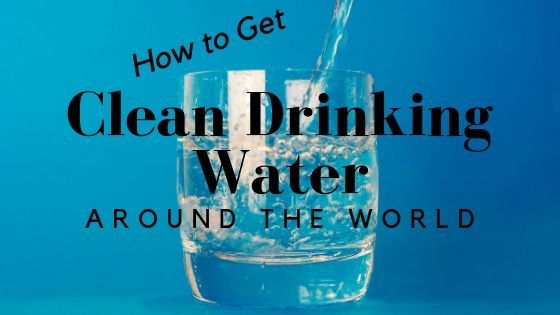

A good write up! Getting sick any time or anywhere is always bad, having it happen somewhere you don’t speak the language has to be worse. Watching your water sounds pretty darn basic!
When I looked at the world map & wondered where the other half of the island New Guinea went, I went back and found it… it was hiding in Asia 🙂
I have a filtered water drinking bottle but I’d rather drink already filtered water than have to suck it through the filter when I want it. When I read about another filtered water bottle, the Grayl Water Filtration Cup (with the purifier filter) I liked the idea. You force the water thru the purifier when you fill the bottle then all you have to do is drink.
Have you heard anything about the Grayl?
I like the clear bottle & 3 hrs tip…
Hi Rob,
No I haven’t heard anything about Grayl, but if the filter is small enough that could be a good way to filter water and use normal water bottles (and drink normally, as you say). If you get one, check back in to this post, and let us know how you like it!
In South America I used water tablets, they were cheap, effective and had no taste. They were particularly useful for my 3 day Lares trek, where the water was provided by locals. What may be considered drinkable by the locals is not always safe for us foreigners, our system is not adjusted properly. Hope you are well.
Great advice, Despina – indeed, not all locals boil or filter their water, because they are used to it. Also, there are some local natural preventatives and cures for parasites that most tourists are not privy to.
I had heard that the water tablets had a bad taste, so it’s good to know that they’ve developed since I researched them. Where did you buy them?
Actually, I’d say it’s a bit more complex than being country wide. There are many places in Canada and the USA you can’t drink the water. In Nicaragua there are some places you can, one good example is the city Leon. No matter what, it’s always good to ask the locals.
Great advice, Anywhereing! The map above is a little generic.
These are really great and helpful tips! Didn’t realize that bleach is safe to consume in little amounts. Good to know!
Yep, I haven’t personally used bleach, but I’ve heard about it before. Even in highly diluted quantities, I’m weary, but it’s better than nothing…
We have a Steripen and it’s been such a saviour and $-saver! It did take a while for us to get used to using it – just swirling a light around in your water didn’t seem like enough at first – but we are converts for sure!
Makes me appreciate having clean water from the tap back home in Canada!
Hey Emily,
TELL me about it! That’s one of the beauties of traveling – in many ways it helps you appreciate those things you take for granted back home. Glad you’re SteriPEN converts!
I can vouch for the steriPen as well. I’ve used mine all over SE Asia, parts of Africa, even India and Nepal without a problem. It doesn’t change the taste or remove chemicals, but it great to always have on hand. I wouldn’t go without it now…. Hope I didn’t just jinx myself …
Jamie,
Nah, no jinxes possible….you’ve got your SteriPEN! 🙂
I’ve been lucky so far I think because I’m not always as careful as I should be.
But the infographic reminded me – back in about 1999 (not long before the Olympics) there was a big giardia outbreak in Sydney – so it can happen anywhere!
Amanda – Great point! And as some readers have pointed out, this infographic isn’t totally accurate; there are spots in the “clean water” countries where the water isn’t potable, and vice versa.
The same goes for things like Hepatitis – I remember visiting a travel clinic before visiting South Africa, and they told me I simply MUST get Hep shots before going there, and showed me this big map of the world where almost every country except Canada and the US were “infected”. This is an outright lie, because it exists in North America as well, and yet we’re not “forced” to get Hep shots in our home countries…
Well, this infographic sure does open my eyes to how many people around this world have to really think about where their water comes from!
I am currently living in South Korea, and though the water is safe, we are told not to drink it here because of hard metals. I think hard metals in water effect you over a lifetime of drinking it, so someone like me who is only living here for a year or 2 shouldn’t be worried. It is something to note though!
Hi Katie,
The infographic did the same for me, helping me realize that clean water is most certainly NOT something to be taken for granted.
I’d be careful about the hard metals in South Korea however, even if you’re there for a year or two….then again I think in many places where the tap water is “safe”, it might not be as healthy as we would like. I have a mechanic/plumber friend in Canada who, once he saw what’s actually inside the pipes, refuses to drink tap water at all. I think that’s a touch drastic, but then again, I never saw what’s inside those pipes….
I have had a dodgy stomach from bottled water and ‘safe’ water, just because it’s from a different country and contains different bacteria to what my stomach is used to. I used a Steripen on bottled water when in Egypt (and was the only person who was not sick) and in my first 6 months of being in Australia (after 3 months of feeling sick, it could only have been the water :/). It took me a year to get used to Australian water (i’m from the UK).
Hi Sarah,
Good point! Some people are more sensitive to different bacteria in the food and water, even if it’s generally considered safe. Glad you’re used to the water in Oz now, and that you have your SteriPEN handy!
I often use sand and paper as a filter in a funnel to clean water during my visit to Southern California.
Hi JinPak,
That’s a very creative and effective filter idea! Glad it worked for you.
My oldest son and his oldest daughter, 17, just did a short camping trip where they were going to live off the land. It was in the U.S., but the neat thing is they really did it! For water, they used a PERSONAL FILTER STRAW purification system that they got on Amazon. I found something similar called LifeStraw. These are very effective. It would be something to include when visiting any country with a questionable water supply.
Great suggestion, Nancy! I believe I’ve seen these online before, and it’s good to know they work a charm.
I just bought a Steripen and will be testing it out traveling through Colombia, Ecuador and Peru. I’ll see how well it works haha!
I’m hoping to use it throughout my treks in the Andes, will bring some Aquatabs as a backup.
Hi Adam,
For me it’s a bit of a leap of faith to just flash a light (aka the SteriPEN) into otherwise risky water to make it drinkable, but (knock on wood) it has served me well! 🙂
Hi Nora,
Do you also have regular health insurance? World Nomads appears to only cover medical emergencies (is this correct?).
Great article on the importance of clean water. We have been pretty happy with our Sawyer and have used it all over Central and South America and now in Asia.
Thanks for putting this together!
Hi Bonnie,
You’re right – World Nomads is pure travel insurance – for medical (and other) emergencies abroad.
Because I’m now a resident of Ontario Canada again, I’m back on the Canadian grid and have health services subsidized, so when I travel, I can just use travel insurance.
But when I was traveling full-time, I had expat insurance – which is also known as international medical insurance, and is basically a worldwide health insurance plan. Here’s more info on that: https://www.theprofessionalhobo.com/expat-insurance-travel-insurance-for-full-time-and-long-term-travelers/
I almost died from dehydration suffered through giardia in India Nora. Violent experience. Biggest scare in my life. I also got vicious food poisoning in Peru. Wow, twas nasty. Both experiences – in the same year – woke me up. I have only been super sick once since, in Myanmar, but other than that I’ve been A-OK living in many developing nations.
Hey Ryan,
I hear you! It just takes a few bad experiences to enforce healthier practices…..
Fyi, the MSR recommendation doesn’t have a carbon filter on it so there won’t be any removal of contaminants… Same with lifestraw unless you get the ‘steel’ version. Still deciding on what to bring… Is there a carbon filter out there you can use easily in addition to steripen that would be quick?
Hi Andrea,
Gosh. I thought from what I read of it that it would be effective on all water-borne ickies of concern (according to the description: “Effective against bacteria (99.9999%), protozoa (99.9%) and particulate; filters up to 2,000 liters without iodine, chlorine or other chemicals”).
Alternately, the Grayl filters everything out, but if you’re doing a large amount of water it’s not particularly fast (or easy).
Yeah I went deep in the water filter internet well last night (pun intended) and it says it won’t do the agricultural products / metals because no carbon filter. I was thinking of actually rigging a carbon filter to the top of the steripen branded particulate funnel to run water through into the water bottle before micro sterilization instead. I found a hack on one of the ultra light backpacker websites that said you could get no-see-um netting and bulk charcoal from an aquarium store to make a pouch.
The other thought I had was to get one of those carbon filter attachments for water faucets that appear in pictures easy to take on and off, but I’m not sure how long they would last (planning on travelling for about a year).
I wish there was some sort of test that you could do to verify if it’s working or not before heading out abroad! (Btw, I’m in love with your website and have been scouring your pages for many hours this last week, great job!)
Hey Andrea,
Wow – you ARE deep in the well, so to speak!
While the self-made carbon filter sounds interesting, I somehow doubt it will be any easier or faster to use than the Grayl.
And the tap filter is a great idea! But….perhaps it won’t fit all taps nor do I believe they are made for putting on and taking off so much.
Given your criteria and length of trip, I’d say the Grayl is where it’s at. And good news – their newer models (I have an older one) are apparently much smoother in operation….
PS – Thanks for the kind words about my site! I’m so glad you’re finding it helpful. 🙂
Try the Camelback Groove. It has a carbon straw built into the cap of the bottle it comes with. The cap also fits on my Nalgene 32 oz bottle. After using the Steripen to kill the bad things, drink the water through the carbon straw to improve taste and remove any particulates. The carbon filter does not remove pathogens, only improves taste.
Thanks for the great suggestion, Dragon!
Hello Nora…need your educated advice. My wife and I are in our 70s and were planning to retire to Cuenca Ecuador from USA…until we read an article about parasites in the soils of Ecuador….and the agonizing treatment needed to rid ones self of these parasites. Ecuadorian farmers apparently don’t use pesticides …but the downside is this allows a proliferation of parasites in the so-called “farm-fresh food” markets/mercados… the article pointed out that natives just accept to situation and get their intestines cleared once or twice a year (which can be worse than parasites)..what do you know about this very important topic?
Hi Michael,
I haven’t heard about this; when I lived in Ecuador and Peru (and traveled through many other countries in South and Central America) the concern was more about the potability of drinking water. And Cuenca apparently is one of the few places where the tap water is actually drinkable (though I still sterilized it).
And I have suffered parasites (a few times – but never in Ecuador); the solution is a cheap 1 or 2-week course of meds that I didn’t find agonizing. The diarrhoea leading up to realizing I had a parasite was the worst part. But, not all parasites are the same either.
While I don’t discount the possibility that the contents of the article you read were true, I would do more research if I were in your shoes. It sounds a bit suspect. If this were a real problem, I’d have thought that everybody would know about it. And I’ve certainly never heard of Ecuadorian farmers not using pesticides; again however – I don’t know.